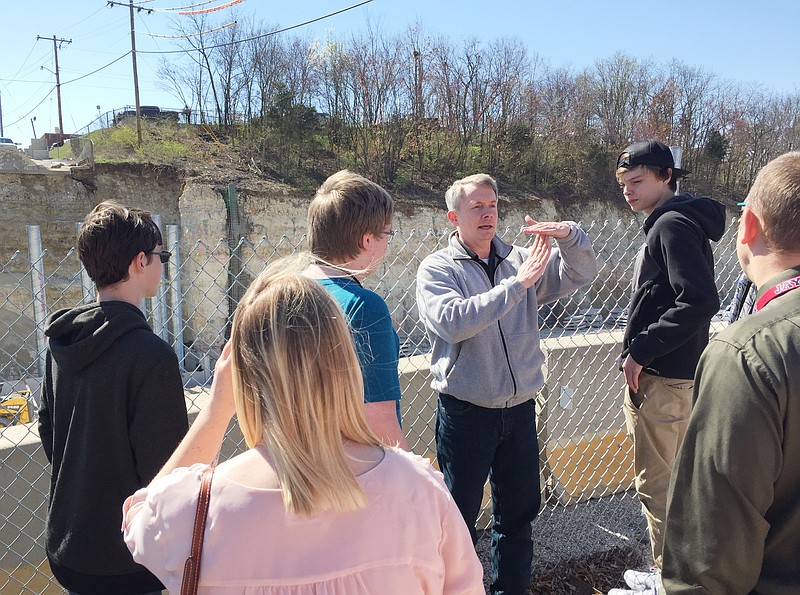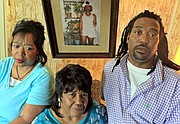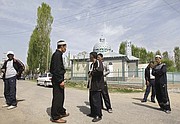The only thing separating the ninth-grade students and a cliff was a chain-link fence overlooking construction below Jackson Street.
The cliff used to be a bridge connecting the street on the opposite end of U.S. 50, but it was torn out and will be rebuilt as part of the Lafayette Interchange project, said Bob Gilbert, vice president for Bartlett & West Inc. in Jefferson City.
Gilbert pointed to the other side of the construction zone, where a small, stone well-house is situated a few feet from the opposite cliff. Gilbert’s team designed an interface wall that will keep crumbling rocks from falling onto the highway, but will preserve the well-house from being damaged by construction.
It was one variable that made the project so difficult, he said — a perfect example of real situations the students could face if they go into engineering. One thing just about every educator has heard at one point or another is, “Why do I have to learn this?â€
For some students, it’s hard to be engaged in the classroom unless they understand why what they’re learning is important, not just that they’ll be tested on it in class.
Jefferson City Public Schools has evolved its teaching approach so the curriculum is relevant to careers and current events. For some students, their math class isn’t just about learning the content — it’s about understanding bullet trajectories or the math behind angles in their welding course.
“It’s like a light bulb lights up, and they’re more engaged,†said Deb Strope, JCPS director of academies.
JCPS staff said career-oriented learning is the education style of the future. Students shouldn’t just be prepared for a four-year university because that’s a one-size-fits-all approach — some students want to go right into the workplace or go to a technical college.
Having real-world applications — like the engineering demonstration — caters to more students’ interests and gets them ready for the working world.
Nichols Career Center has been an option for local students to get a jump on transitioning into a career since 1976, but JCPS has recently added more career-integrated options by adopting Project Lead the Way curriculum and adding the academies.
All three offer opportunities for students to connect with local businesses for inside input on what their profession truly entails; and, at some point, all the pathways will have some sort of internship.
“People have a misconception that we’re changing the learning targets, but we don’t control that, the state does,†Strope said. “We cater a learning target to a career.
The academies
The school district added the academy model two years ago and announced in December it would reconfigure the tracks from seven to three so students would have broader options.
The new academies will be:
• Health/human services
• Agriculture/industrial engineering and technology
• Communication, arts, and business and global studies.
There will also be a general track, much like a typical high school setting, students can choose.
The new academy schedule is still under construction, but students will have the option to: choose courses within their academy track at Nichols; earn an entry-level, industry-recognized certificate; take Project Lead the Way courses; and potentially earn college credit or take the general academy classes.
Strope said the impetus behind adopting the academy model was so students would get exposure to careers early and figure out what they’re interested, but also to determine what they’re not interested in.
“I had a student who wanted to be an emergency room doctor,†she said. “He was taking medical chemistry and shadowed an ER doctor for one night. He came back the next day and said, ‘This isn’t for me.’â€
About 200 business partners have either been a guest speaker or project facilitator or helped with a job shadow or internship. Business partners are an integral part of the academies, Strope said. They provide industry knowledge and give students a sneak peak into their careers.
Gilbert is among the business partners who have an active role in the schools.
“I remember my experience and what value this would have been to me,†he said. “I hope it benefits them and drives them in what they can apply in learning. If they’re happy, they’ll learn better. …
“On the receiving side as a business, we’re an engineering professional business and we need recruits. The supply isn’t meeting the demand. Our company is benefiting from locals getting education and coming back to work. The best recruits are from here.â€
Another piece of the academies is integrated courses, like the fused biology-literature course that formed four years ago when the district started discussions about adding academies.
Teachers Rhiannon McKee and Abigail Nahlik co-teach the yearlong, project-based course, intertwining biology lessons with science-based literature.
They keep the curriculum relevant by tying lessons to current events, so the projects each year are different. This year, they read a couple of traditional novels, including “Brave New World.†But they have also gone beyond the typical high school reads with “The Seven Daughters of Eve,†a non-fiction novel about a particular strand of DNA that passes through the maternal line, allowing scientist to trace Europeans’ ancestry back to seven primeval women, according to an Amazon description of the book.
“I think people want kids to enjoy reading, but have a hard time letting go of the core (high school) books,†Nahlik said. “But students learn the skills reading anything. I’m a big fan of integrated classes because it makes it much more relevant. Everything is cross-curricular. They (the students) always say we never do anything for English, but they’re reading an article and answering questions. That’s what I would teach in English; it just might not be about science.â€
McKee said the course works well because it satisfies the sophomore-level English class and the required biology course. Several students who take the integrated course are in the health services academy track, so it’s relevant to what they’re learning in other classes.
Project Lead the Way
Project Lead the Way is also fairly new to the district, having been adopted by the high school four years ago. The high school subscribes to all three subjects offered by the foundation: computer science, biomedicine and engineering.
The biomedical program recently received national certification, so JCHS students have the opportunity to earn college credit at a reduced price. The Advanced Placement program partnered with the computer science program, which will strengthen both courses.
Project Lead the Way began in 1997 at 12 high schools in upstate New York and is now offered in more than 8,000 schools nationwide, according to Project Lead the Way’s website.
The rigorous curriculum is built around strengthening critical-thinking skills to solve problems, said Karen Brickey, JCPS’s Project Lead the Way coordinator. She said schools that are using PLTW’s curriculum are behind.
With technology innovations evolving so quickly, it’s hard to prepare kids for future jobs because the jobs some students will enter don’t exist yet. Brickey said if students are skilled in problem-solving then they should be prepared for what career fields will be like by the time they graduate.
“Project Lead the Way fits so well into the academies approach, whether it’s our school or any other,†Brickey said. “Rather than sitting in a classroom, we want our kids using critical-thinking skills. Critical thinking, that’s the 21st century. If you can communicate a problem, you’re more likely to adapt to the changing world.â€
The foundation insists on having business partners, which also fits well with the academies. Each program has business partners it works with who give class presentations or critiques projects.
One class has been designing the skeletal configuration and plumbing of a house for several weeks. Three retired men from the engineering or construction business came in to give feedback on how to create better flow and functionality.
“The kids love it when they come into the classroom,†she said. PLTW is focused on STEM (science, technology, engineering and math). There’s potential the programs will expand in the future to incorporate the arts, Brickey said, but right now the foundation is focused on building those programs.
Nichols Career Center
“In today’s world, a four-year degree is a degree, but it may not equal a career.â€
— Sharon Longan, Nichols Career Center director
When Nichols Career Center opened in 1976, not only was it front-page news, it had its own special section in the Sunday newspaper featuring the newly constructed building and the programs offered.
The courses reflected the local economic need at the time: key punch machine operation, secretarial practice and consumer home economics, to name a few. Some programs have been revamped or added as industry change demanded, but the goal has remained relatively the same.
Students who attend Nichols aim to be ready to jump into entry-level jobs within their program of study.
Nichols now has 12 programs, all of which can result in a certificate, some of them industry-recognized.
“They’re able to walk into the industry and be more attractive to employers because they don’t have to train them,†said NCC Director Sharon Longan. “Our students already have that training, so it gives them a leg up.â€
Students who want to attend Nichols have to be interviewed and assessed based on their grades, attendance and behavior before being accepted.
It’s a serious time commitment, said counselor Travis Plume. Only juniors and seniors are eligible to attend, and they spend half their day for two years taking Nichols classes.
But if they take the test and earn their certificate, they’re able to work in entry-level jobs right out of high school. They also build employer contacts during internships and business partners that collaborate with the programs.
“The beauty of a CTE is that it’s time-condensed,†Plume said. “They’ll get out in the career field faster. We have a lot of students that crave that real-world application. Their passion is getting their hands dirty and getting in the shops. That’s the beautiful thing about Nichols.â€
Every program has an advisory council made up of students, former students, parents, business partners and post-secondary representatives. The council ensures each program is teaching to current industry needs, Longan said.
If there isn’t a demand for a program anymore, there’s a chance it could be cut, she said. If there’s a need for a new program, the center looks at the local labor need, student interest and building space before submitting a request to the Department of Elementary and Secondary Education.
The culinary arts program is the newest at the career center. Classes were offered in 2014, but it wasn’t until fall 2015 that a state-of-the-art kitchen was installed.
Much like the academies and Project Lead the Way, Nichols programs use hands-on projects to teach career-relevant material.
In the auto-collision course, the teacher has students build a car fender or door from scratch, Longan said. After it’s sanded, coated and painted, the teacher puts a hole or scratch in it. The students then have to restore the fender or door as if it never happened.
“Students critique their work themselves, and it builds critical-thinking skills,†she said.
Longan said there’s a stigma that technical education centers are less valuable than a four-year degree, but statistics prove otherwise.
“In today’s world, a four-year degree is a degree, but it may not equal a career,†she said. “Career and technical education is a more direct route in a career. If success equals a paycheck, a welder earns a decent paycheck, and it requires less schooling."
For more local business coverage, read the full April 25, 2016, issue of #jcmo Inside Business.



